How To Use The Raizer M Lifting Chair To Lift A Fallen Person; A Step-By-Step Guide
In this guide, we will take you through the process of lifting a fallen person off the floor safely and quickly, using the Raizer M Lifting Chair. This whole process can be easily and safely carried out by one person.
If you would prefer to watch a video showing this process, the below video is for you!
Always assess whether the fallen person is safe to lift
Before attempting to lift the fallen person, it’s very important to check whether the fallen person has any pain, discomfort, or injuries. Skipping this step may lead to further injury or complications for the fallen person.
To thoroughly check a fallen person for injury, we recommend that you use a clinically approved assessment tool such as HelpFall or IStumble.
| Click here to view HelpFall |
When it is clear that the fallen person is safe to lift, we can use the Raizer M chair to lift them from the floor.
Step One: Insert the Raizer seat unit
The first step is to ask the fallen person to lift their knees, and you may need to assist them with this.
The Raizer seat unit can now be inserted underneath the knees, tucking the black side up against the fallen person’s thighs.
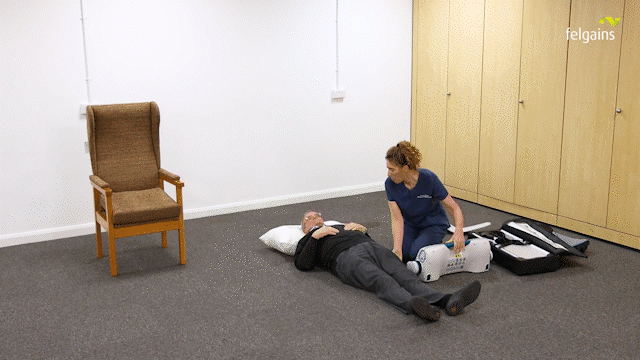
Step Two: Insert the two backrests and secure the seatbelt
To insert the backrests underneath the fallen person, ask them to cross their arms so that each hand is on the opposite should. Again, you may need to assist them in doing this.
Doing this raises the fallen person’s shoulders from the ground, which allows you to slide the backrests under their back and insert them into the slots on the Raizer seat unit. The two backrests are identical; either backrest can go in either slot.
Once the two backrests are inserted, the next step is to do up the seatbelt. The seatbelt can be slid up the backrests to offer more support for the chest, if required.
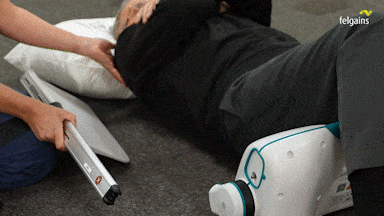
Step Three: Attach the four lifting arms
The four lifting arms can now be inserted into the remaining four slots on the Raizer seat unit.
Again, all four of the Raizer lifting arms are identical and can be inserted into any of the four slots on the seat unit, so it’s impossible to assemble them incorrectly.
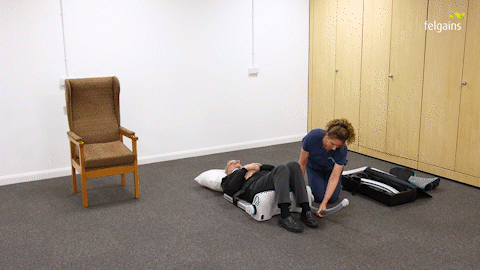
Step Four: Insert the headrest
You can now insert the headrest by sliding it between the fallen person’s back and the Raizer backrest, which will support the fallen person’s head while you lift them from the floor. Alternatively, if you have a second carer they can support the fallen person’s head.
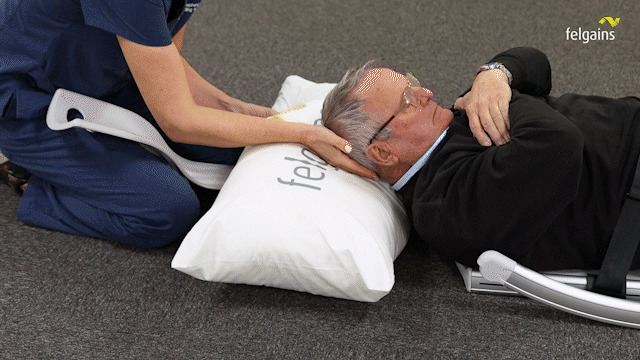
Step Five: Use the crank handle to lift the fallen person from the floor
You can now place the crank handle into the side of the seat unit and turn the handle clockwise to start raising the fallen person from the floor.
You can pause at any point during the lift by simply stopping rotating the crank handle. You may need to do this once the Raizer has lifted the faller into a seated position, to allow them to get their bearings and get settled before moving on.
When they are ready, the Raizer can be lifted to its full height, which takes the person into a perching position and allows you to assist them to transfer easily.
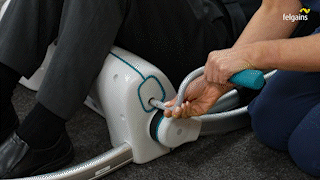
Step Six: Once the lift is complete, lower and disassemble the Raizer
Once the lift is complete and the fallen person has safely transferred from the Raizer, it’s time to disassemble the Raizer, ready for its next use.
It’s very important to completely lower the Raizer to the floor before disassembly, to ensure the Raizer is in the right position for the next lift.
________________
And that’s it, you have successfully lifted someone from the floor using the Raizer M lifting chair.
For a guide on how to lift someone using the Raizer 2 Lifting Chair, please see here.
For a guide on how to lift someone using a mobile hoist and sling, please see here.
Related articles
What Causes Falls In The Elderly?
Raizer Lifting Chairs vs Mangar Inflatable Lifting Cushions; An Honest Comparison
Best Falls Lifting Equipment For Care Homes In 2023
Get in touch
Got a question or want to send us a message? Let’s talk.